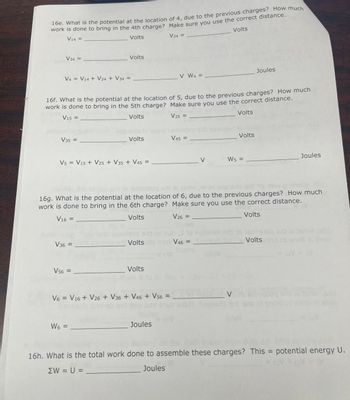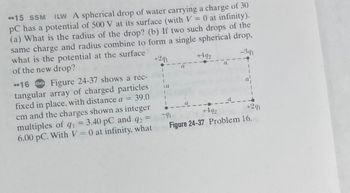Question

Transcribed Image Text:16e. What is the potential at the location of 4, due to the previous charges? How much
work is done to bring in the 4th charge? Make sure you use the correct distance.
Volts
V14 =
Volts
V24 =
V34 =
V4 = V14 + V24 + V34= =
16f. What is the potential at the location
work is done to bring in the 5th charge?
V15 =
Volts
V35 =
Volts
V5 = V15 + V25 + V35 + V45 =
V36 =
V56 =
Volts
W6 =
Volts
Volts
V6 = V16 + V26 + V36 + V46 + V56 =
V W4 =
Joules
of 5, due to the previous charges? How much
Make sure you use the correct distance.
V25 =
Volts
16g. What is the potential at the location of 6, due to the previous charges? How much
work is done to bring in the 6th charge? Make sure you use the correct distance.
V16 =
Volts
V26 =
Volts
V45 =
V
V46 =
Volts
W5 =
Joules
V
Joules
di al 16
Volts hd of snob al
= SV
V
pol
16h. What is the total work done to assemble these charges? This = potential energy U.
ΣW = U =
Joules

Transcribed Image Text:**15 SSM ILW A spherical drop of water carrying a charge of 30
PC has a potential of 500 V at its surface (with V = 0 at infinity).
(a) What is the radius of the drop? (b) If two such drops of the
same charge and radius combine to form a single spherical drop,
what is the potential at the surface
of the new drop?
-341
+291
16 Go Figure 24-37 shows a rec-
tangular array of charged particles
fixed in place, with distance a = 39.0
cm and the charges shown as integer
multiples of q₁ = 3.40 pC and q2 =
q1
6.00 pC. With V = 0 at infinity, what
la
1
+492
+291
-91
+492
Figure 24-37 Problem 16.
Expert Solution
arrow_forward
Step 1: Know the concept:
Since you have posted multiple questions, we will provide the solution only to the first question as per our Q&A guidelines. Please repost the remaining questions separately.
Electric potential at the surface of a sphere:
The electric potential () at the surface of a sphere is given by the equation,
where is the Coulomb's constant,
is the total charge on the sphere, and
is the radius of the sphere.
Step by stepSolved in 5 steps with 23 images

Knowledge Booster
Similar questions
- A small object with a mass of 270 μg carries a charge of 20.0 nC and is suspended by a thread between the vertical plates of a parallel-plate capacitor. The plates are separated by 5.00 cm. If the thread makes an angle of 13.0° with the vertical, what is the potential difference between the plates? Varrow_forwardAsaparrow_forwardA 0.500 cm diameter plastic sphere, used in a staticelectricity demonstration, has a uniformly distributed 40.0 pC charge on its surface. What is the potential near its surface?arrow_forward
- What are (a) the charge and (b) the charge density on the surface of a conducting sphere of radius 0.16 m whose potential is 300 V (with V = 0 at infinity)? (a) Number Units (b) Number Unitsarrow_forwardA 0.53-cm-diameter plastic sphere, used in a static electricity demonstration, has a uniformly distributed 36-pC charge on its surface. What is the potential near its surface?arrow_forwardFour positive charges (+20 microC each) are to be arranged at the corners of a square of side d = 0.5m. d + + d + b) What is the potential at the center of the square? (KV = kilovolts) %3Darrow_forward
arrow_back_ios
arrow_forward_ios